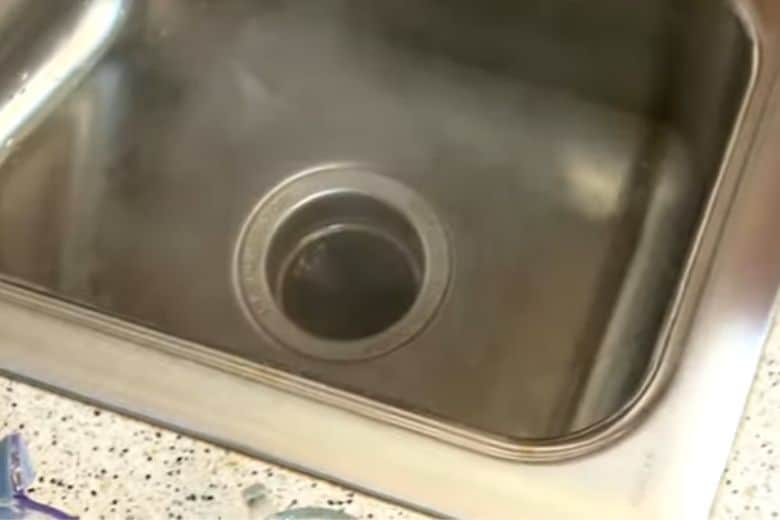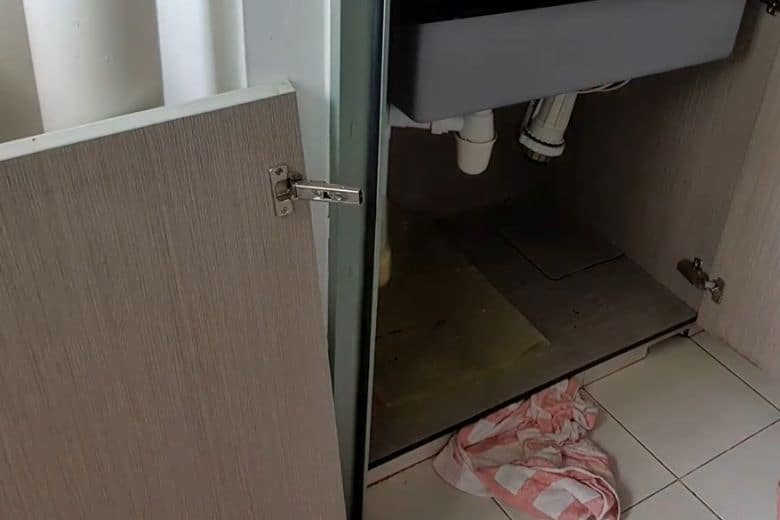Do you think your garbage disposal blades are loose? If yes, then you will surely face a tough situation. Since garbage disposal is an essential kitchen appliance that helps you to clean and maintain your kitchen drainage from debris, clogs, or food parties.
Generally, it is a device mounted under the kitchen sink and is connected to the drainage system. It has two blades that rotate at high speeds, chopping up food waste to allow easy passage through the drainage.
Consequently, when the garbage disposal blades become loose and wobbly, it creates problems with the machine’s functionality and safety hazards.
Therefore, neglecting the problem can raise several issues, including clogging, foul odors, and decreased performance.
So, what to do?
Well, before tightening your garbage disposal blades, you have to figure out the signs indicating a problem with the unit.
Some of the Common Signs of Loose Garbage Disposal Blades Are:
- The unusual and strange noise from the garbage disposal clearly indicates that the blades are loose and need tightening. These sounds may include rattling, clanking, grinding, or humming.
- Another sign of loose garbage disposal blades is slow or ineffective food waste grinding. As it happens, it will cause clogs and unpleasant odors.
- Water backing up into the sink, water damage, and even water leaking under the sink could be a sign your garbage disposal blades are loose.
- Lastly, when the blades are loose, the garbage disposal unit may overheat, leading to reduced performance or total failure.
The Reason Behind Your Garbage Disposal Blades Are Loose
Now you know the sign that indicates your garbage disposal blade has become loose. But what is the reason it happened? However, we have pointed out a few reasons for this occurrence. Have a look.
1. Wear and Tear:
The blades in a garbage disposal unit can wear down due to constant use for a year or more. These can cause the blades to become loose and less effective in grinding food waste.
2. Rust and Corrosion:
Exposure to moisture and acidic substances can cause rust and corrosion on the blades, making them loose and less effective.
3. Incorrect Installation:
If the garbage disposal unit is not installed properly, it causes the blades to become loose over time. It happened because the blades may not be properly aligned, which pushes them to hit the sides of the unit.
4. Excessive Use:
The enormous use of the device also causes the blades to become loose due to the strain on the motor.
5. Foreign Objects in the Garbage Disposal:
Finally, when you accidentally place non-food objects in the garbage disposal unit, they can damage the blades and cause them to become loose.
How to Tighten Garbage Disposal Blades
Before tightening the garbage disposal blades, you must make necessary preparations to ensure safety and efficiency. Moreover, to tighten the garbage disposal blades, you need to arrange the following tool:
- Screwdriver
- Wrench or Allen wrench
- Replacement blades (if necessary)
- Toothbrush or cloth (for cleaning)
Step 1:
Turn off the power and ensure, the garbage disposal unit is not connected to any electrical source. You can either unplug the unit or switch off the circuit breaker.
Step 2:
Next, to access the blades and mounting assembly, you must remove the disposal from the sink. Make sure to follow the manufacturer’s instructions for doing so. And use a flashlight to inspect them.
Step 3:
After disconnecting the garbage disposal from the sink, locate the mounting assembly that attaches the disposal to the sink because loose mounting bolts are the main reason for the disposal’s loose blades.
However, this assembly consists of a metal ring, mounting bolts, and a support ring. Besides, three bolts hold the mounting assembly in place.
Step 4:
Step four will need if your blades are damaged, worn out, or beyond repair. Check the blades for any signs of damage, such as chips or cracks or excessive wear and tear. If you notice any damage, you will need to replace them. Buy a matching garbage disposal blade and follow the step.
First, remove the mounting screws that secure the blades in place. Then remove the old blades and replace them with the new ones, securing them with the mounting screws. It is simple and easy to do.
Next, check the mounting assembly for any damage, such as cracks, corrosion, or wear and tear signs. If you notice any issues, it may be necessary to replace the mounting.
Step 5:
However, whereas you found your garbage disposal blade is not damaged and only needs to be tightened. Before moving to the next step, clean the blades and the disposal chamber, and use a brush or cloth to clean any debris or buildup. It will help ensure the unit operates efficiently and reduce clogs or blockage risk.
Step 6:
Now, you can tighten the bolts using a pillar or wrench. Start with the top screw and then move to the bottom one. Tighten each screw gradually, alternating between them until they are both securely in place.
Tighten each bolt in a clockwise direction. Here you need to be careful not to over-tighten because it will damage the blades or other components of the disposal.
Once the screws are tight, use an Allen wrench to rotate the flywheel. It will help confirm that the blades are evenly tightened and reduce the risk of jams or clogs.
After tightening the blades, reconnect the disposal to the sink following the manufacturer’s instructions.
Check the blades are still lose by attempting to move them. If the blades are still loose, adjust them to ensure they are properly aligned.
Step 7:
After the blades are tightened or replaced, now turn on the power to the disposal and run water to test its function. Therefore, ensure the disposal runs smoothly and no leaks or unusual noises. Therefore, also try to listen for any unusual noises or vibrations.
Note:
Although tightening garbage disposal blades is a smooth and straightforward job. Despite that, if you are uncomfortable performing these repairs yourself or the issue is more complex, it is best to seek professional help. A licensed plumber or appliance repair technician can diagnose and fix the issue safely.
How to Maintain Garbage Disposal
Certainly, there are a few ways you can follow and obey to maintain your disposal unit for its long lifespan. In order to ensure a well-functioning garbage disposal unit, you should maintain it properly. Let’s see the maintenance process.
1. Avoid Grinding Hard or Fibrous Materials:
Garbage disposals are not designed to handle hard or fibrous materials. Some foods and materials can damage your garbage disposal unit or cause it to clog. For example, putting bones, grease, eggshells, coffee grounds, and fibrous vegetables (like celery) into the unit can damage and malfunction the device and loosen the blade easily.
So, avoiding putting them into your disposal unit is a great way to maintain the device.
2. Regular Cleaning:
To prevent debris buildup and maintain the efficiency of your garbage disposal, clean it regularly. You can do this by pouring a mixture of baking soda and vinegar down the disposal, followed by hot water.
You can also clean the garbage disposal by running cold water and some dish soap through the unit. Furthermore, you can use ice cubes and citrus peels to clean and deodorize them.
Lastly, use ice and rock salt or lemon or orange peels to keep the blades clean and odor-free. It will help remove any buildup and keep the blades sharp.
3. Run Cold Water When Using the Disposal:
The cold water helps keep the blades and other components of the disposal cool and prevents overheating and damage.
So, running the disposal using cold water instead of hot water will be wise. The cold water helps solidify any fats or oils in the waste, making them easier for disposal to grind up and preventing clogs.
But that does not mean you cannot use hot water. You can use hot water for cleaning or other reasons but not for everyday use.
4. Do not Overload the Disposal With too Much Waste at Once:
Your garbage disposal unit is designed to handle small amounts of food waste at a time. Avoid overloading the unit or trying to grind large or tough items, as this can cause damage to the blades.
To avoid overloading the disposal, feed it small amounts of waste at a time. It will help prevent jams and ensure that the disposal operates efficiently.
5. Use the Disposal Regularly:
Running the disposal regularly can help keep the blades moving and prevent them from becoming stuck or rusty.
Note:
Maintain your garbage disposal unit to expand its lifespan, reduce the risk of injury or damage, and improve the drainage system. Consequently, you will enjoy these benefits and avoid the inconvenience and expense of dealing with issues caused by a poorly functioning unit.
Frequently Asked Questions
Is it safe to fix my garbage disposal blades on my own?
Answer: If you have experience with plumbing or electrical work, fixing your garbage disposal blades may be safe. However, when you are unsure about what to do, in that case, it’s best to seek professional help to avoid the risk of injury or further damage to the unit.
How long should my garbage disposal unit last?
Answer: The lifespan of a garbage disposal unit depends on several factors, such as the frequency of use, quality of the unit, and maintenance. On average, a well-maintained garbage disposal unit lasts 10-12 years.
How much does it cost to replace garbage disposal blades?
Answer: The cost of replacing garbage disposal blades varies depending on the unit’s make and model and the labor cost in your area. On average, the cost can range from $50 to $150.
How often should I clean my garbage disposal unit?
Answer: You should clean the garbage disposal unit once a week. These can be done by running cold water and adding a small amount of dish soap to the disposal while it’s running. You can also use ice cubes and citrus peels to help clean and deodorize the unit.
Conclusion
To wrap up, we have included all possible reasons why garbage disposal blades are loose and how to tighten garbage disposal blades. Hopefully, you have found our article helpful, and direct from here, you can move to your kitchen to solve the issue. That is all for today. Have a safe work!
Paul Newman is a blogger who writes about plumbing and home improvement. Over the past 20 years, I have worked as a plumber. My passion is to share my knowledge and experience with others to improve their homes.




